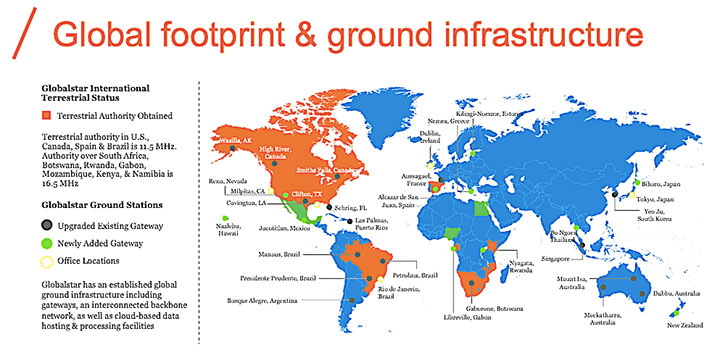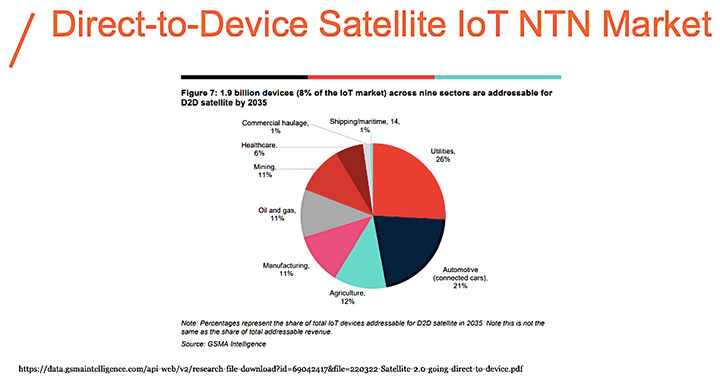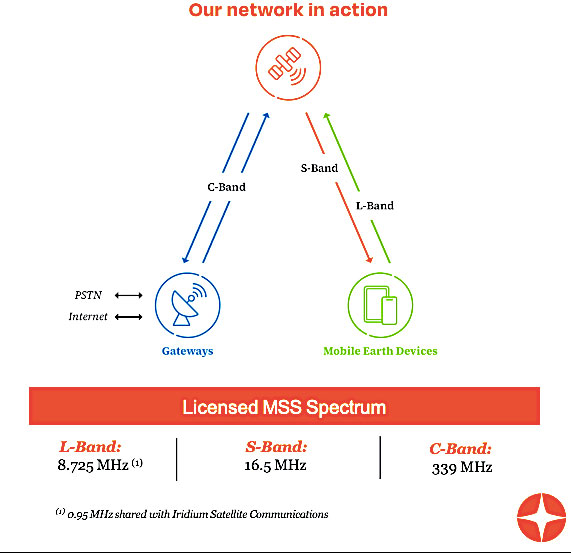 (Source: Globalstar November 2023 investor presentation)
(Source: Globalstar November 2023 investor presentation)
LA PLATA, Maryland — Some current and prospective satellite constellation operators in the past year have switched their focus from IoT to direct-to-device (D2D) on the assumption that today’s emergency-text service will expand to full broadband connectivity from a satellite to an unmodified smartphone and find a large market.
Much of the shift in attention has followed Apple’s late-2022 introduction of an emergency-text feature on new iPhones using Globalstar satellites. Apple is financing a new generation of Globalstar satellites to launch in 2025 and has reserved 85% of their capacity. Globalstar has the remaining 15%.
Apple has been offering the service free of charge to help subscribers in trouble and out of terrestrial coverage. The company has been silent on whether it believes a vast new market ultimately will open with a new generation of satellites, or whether the service will remain an add-on to stimulate handset sales.
But Globalstar has not been silent, and it is moving against the flow of money and market attention, saying it’s far from clear that the market for broadband D2D is big enough to justify the satellite investment.
 Globalstar Chief Executive Paul E. Jacobs. (Source: CNBC video)
Globalstar Chief Executive Paul E. Jacobs. (Source: CNBC video)
Globalstar’s contrarian view is all the more notable because it’s coming from Chief Executive Paul E. Jacobs, former CEO of Qualcomm, whose founding CEO is Jacobs’s father. Irwin Jacobs in 1991 signed the joint venture with Loral Corp. that created Globalstar.
Globalstar’s voice-and-data business through special Globalstar handsets ran into bankruptcy when it became clear that the spread of terrestrial wireless left Globalstar, and competitor Iridium Communications, with a market that was too small to justify the investment in satellite and ground hardware.
Globalstar has since reinvented itself, following multiple investments by current Executive Chairman Jay Monroe and his family, into a company targeting terrestrial markets, principally government and enterprise, using Globalstar’s satellite spectrum.
 (Source: Globalstar November 2023 investor presentation)
(Source: Globalstar November 2023 investor presentation)
Jacobs says the IoT market for private corporate networks, emergency services and government use has huge potential and will be Globalstar’s focus. He’s leaving to others the task of making the substantial investment in satellite capacity needed to provide 5G-equvalent throughput from standard smartphones.
In his remarks to Globalstar investors and during the Dec. 12-13 Future of Wireless, AI and Connectivity Conference, organized by New Street Research and BCG, Jacobs comes off as someone as curious as anyone about how the SpaceX/T-Mobile, AST SpaceMobile, Lynk Global and other D2D investments will turn out.
He did not discuss Qualcomm’s recent decision to end an agreement with Iridium to embed Iridium connectivity into Qualcomm’s SnapDragon modem. Qualcomm said Android handset manufacturers showed little interest in it.
“There is going to have to be a lot of creativity because there is a lot of money flowing into the area,” Jacobs said. “I don’t know whether the cellular operator is going to be able to charge extra for it. If you think of the satellite as a cell site being up in the air, are you gong to pay more for that, and under what circumstances?”
The buzz surrounding D2D’s future broadband potential is such that even companies like Globalstar and Iridium must address it even if their current position is basically: We’ll see, and we’re not investing in it.
Jacobs said that Globalstar’s voice-and-data service wasn’t sustainable 30 years ago even though it was just 48 relatively simple, bent-pipe satellites. If those basic market dynamics have not changed, he said, it will be hard to justify launching constellations that are hugely more costly and complicated.
Jacobs used his Globalstar experience to question whether satellite companies striking deals to use spectrum licensed to terrestrial carriers is a superior choice to using spectrum that has been reserved worldwide for mobile satellite use.
The former strategy has the advantage of winning mobile network operator (MNO) backing because the satellite link will appear as an app on their customers’ phones, with customer management handled by the MNOs. But that also means winning global regulators’ approval.
“Going the carrier route means a lot of regulators, and space adds complexity because people are very conscious of where the data is going, where it is hosted and who sees what,” Jacobs said.
Going the MSS-spectrum route means building businesses nation by nation, from the ground up. Globalstar, Iridium and the now-Viasat Inc.-owned Inmarsat have done this. So has the UAE’s Yahsat-owned Thuraya, which provides mobile connectivity from satellites in geostationary orbit.
Globalstar is heading in the opposite direction, to get terrestrial authorization for its satellite spectrum. It has licenses in 11 nations, he said.
 (Source: Globalstar)
(Source: Globalstar)
Jacobs came to Globalstar after founding XCom, which has developed a spatial processing technique that squeezes more capacity — a multiple of 5x or 10x — from a given swath of radio spectrum. Globalstar’s spectrum is not subject to a primary allocation to another user, such as the military, meaning customers with mission-critical applications can be given guarantees that it will be there.
8-9 new satellites to launch in 2025, bringing constellation to 32
Globalstar’s current fleet is 24 second-generation satellites and one space, plus a few first-generation spacecraft. Using Apple financing, Globalstar has ordered 17 third-generation satellites from Canada’s MDA Corp., with Rocket Lab as a major subcontractor. Eight or nine of these are scheduled for launch aboard a SpaceX Falcon 9 rocket in 2025.
